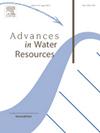Dynamics of bedload transport under run-up wave by gravel resolved scheme based on 3D DEM-MPS coupling
IF 4.2
2区 环境科学与生态学
Q1 WATER RESOURCES
引用次数: 0
Abstract
Accurate predictions of morphological changes in swash zones require a detailed understanding of sediment transport mechanisms, which are strongly related to bore-induced vortices and turbulence, surface-subsurface interactions, namely, infiltrate/exfiltrate flow, and swash-swash interactions. However, obtaining experimental or field measurements of instantaneous velocity and sediment flux is challenging owing to the suspended sediment, turbulence, and shallow depth characteristics of these regions. The present study simulates the gravel bedload transport under a dam-break bore at a grain-resolved spatial scale. The simulation uses a 3D Lagrangian–Lagrangian solid–fluid coupled model comprising the moving particle semi-implicit (MPS) method for a violent swash flow and the discrete element method (DEM) for gravels. The simulated water depth, velocity, and sediment flux agree with existing experimental results during a run-up. The gravel transport mechanisms for the lower, mid, and upper swash zones were discussed. Discussions on bedload mechanisms reveal that bore-generated horizontal vortices can reduce the onshore velocity near the beach surface, reducing sediment flux in the lower swash zone. Modified Shields numbers investigate the seepage effects: the frequently used standard Shields number value is insufficient to estimate bedload flux under the intense infiltration in the mid-swash zone. The simulation result also elucidates the turbulence characteristics in the upper swash zone.
基于三维 DEM-MPS 耦合的砾石解析方案研究波浪上升时的床面负荷迁移动力学
要准确预测斜流区内的形态变化,就必须详细了解沉积物的迁移机制,这与钻孔引起的涡流和湍流、表层与次表层的相互作用(即渗入/渗出流)以及斜流与斜流的相互作用密切相关。然而,由于这些区域的悬浮沉积物、湍流和浅水特性,获取瞬时速度和沉积物流量的实验或实地测量数据非常困难。本研究以颗粒分辨的空间尺度模拟了溃坝孔下的砾石床载输移。模拟采用了三维拉格朗日-拉格朗日固-流体耦合模型,其中包括针对剧烈斜流的移动颗粒半隐式(MPS)方法和针对砾石的离散元方法(DEM)。模拟的水深、流速和泥沙通量与现有试验结果一致。讨论了下、中、上斜流区的砾石输运机制。关于床面负荷机制的讨论表明,钻孔产生的水平涡流可降低海滩表面附近的岸上速度,从而减少下斜流区的沉积通量。修正的希尔兹数研究了渗流效应:常用的标准希尔兹数值不足以估算中冲刷带强渗流情况下的泥沙通量。模拟结果还阐明了上游冲刷区的湍流特征。
本文章由计算机程序翻译,如有差异,请以英文原文为准。
求助全文
约1分钟内获得全文
求助全文
来源期刊

Advances in Water Resources
环境科学-水资源
CiteScore
9.40
自引率
6.40%
发文量
171
审稿时长
36 days
期刊介绍:
Advances in Water Resources provides a forum for the presentation of fundamental scientific advances in the understanding of water resources systems. The scope of Advances in Water Resources includes any combination of theoretical, computational, and experimental approaches used to advance fundamental understanding of surface or subsurface water resources systems or the interaction of these systems with the atmosphere, geosphere, biosphere, and human societies. Manuscripts involving case studies that do not attempt to reach broader conclusions, research on engineering design, applied hydraulics, or water quality and treatment, as well as applications of existing knowledge that do not advance fundamental understanding of hydrological processes, are not appropriate for Advances in Water Resources.
Examples of appropriate topical areas that will be considered include the following:
• Surface and subsurface hydrology
• Hydrometeorology
• Environmental fluid dynamics
• Ecohydrology and ecohydrodynamics
• Multiphase transport phenomena in porous media
• Fluid flow and species transport and reaction processes
 求助内容:
求助内容: 应助结果提醒方式:
应助结果提醒方式:


